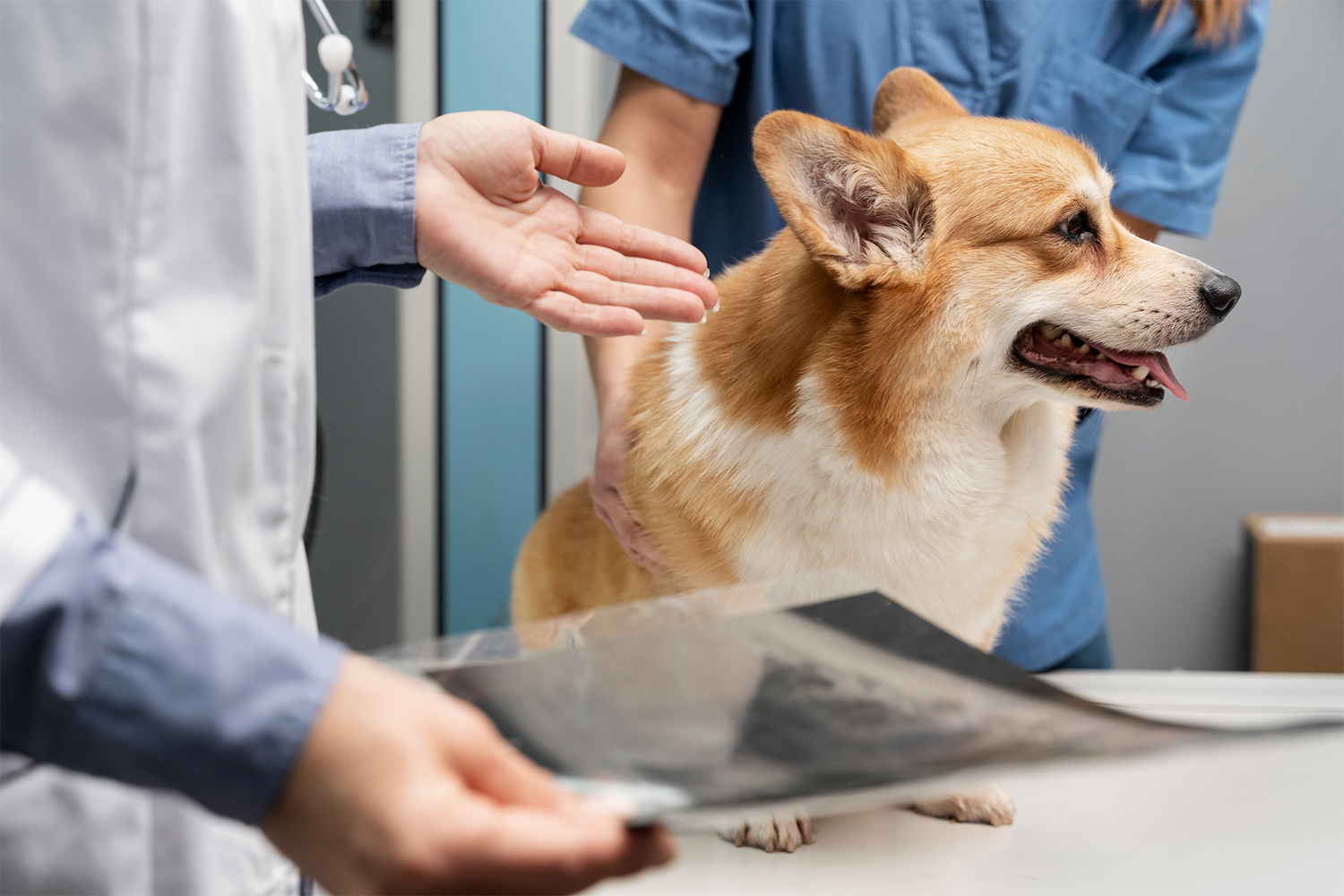Understanding Fractures in Dogs
Fractures occur when a bone breaks due to excessive force or underlying weaknesses. They can range from minor hairline cracks to severe breaks requiring surgical intervention. Understanding the causes, symptoms, and treatment options can help dog owners act quickly to support their pet’s recovery.
Common Causes of Fractures in Dogs
Several factors contribute to fractures in dogs, including:
- Trauma: Accidents such as being hit by a car, falls from high places, or rough play can lead to bone fractures. Studies indicate that high-impact trauma is the leading cause of fractures in dogs, accounting for nearly 70% of cases.
- Nutritional Deficiencies: A lack of essential nutrients, such as calcium, phosphorus, vitamin D, and collagen, can weaken bones, making them more prone to fractures. A 2021 study published in the Journal of Animal Nutrition found that dogs with low collagen levels had an increased risk of bone fractures due to reduced bone flexibility.
- Osteoporosis and Bone Diseases: Conditions like osteoporosis or metabolic bone diseases can reduce bone density, increasing fracture risk. Research from the Veterinary Orthopedic Journal highlights that osteoporosis in aging dogs is a growing concern that leads to fragility fractures.
- Genetic Predisposition: Some dog breeds, such as Greyhounds, Chihuahuas, and Dachshunds, are more prone to bone issues and fractures due to genetic factors.
Signs and Symptoms of Fractures in Dogs
Recognizing the signs of a fracture early can ensure timely intervention. Common symptoms include:
- Sudden limping or refusal to bear weight on a limb
- Swelling, bruising, or visible deformities
- Whining or signs of pain when touched
- Loss of appetite and reluctance to move
- Unusual positioning of a limb or abnormal gait
If your dog exhibits any of these symptoms, a veterinary consultation is necessary for proper diagnosis and treatment.
Diagnosis and Treatment Options for Dog Fractures
Veterinarians use a combination of diagnostic tools and treatment methods to address fractures, depending on their severity:
- Veterinary Diagnosis - A veterinarian will perform X-rays or CT scans to assess the severity and location of the fracture. Blood tests may also be conducted to check for underlying bone conditions.
- Splints or Casts - For minor fractures, immobilizing the affected limb may be sufficient for healing. According to the American Veterinary Medical Association (AVMA), small, non-displaced fractures can heal within 4-6 weeks with proper immobilization.
- Surgery - Severe fractures often require surgical intervention, including bone plates, pins, or external fixation devices. A study published in Veterinary Surgery suggests that dogs undergoing surgical repair for long bone fractures have a 90% recovery rate when combined with proper post-operative care.
- Pain Management - Anti-inflammatory medications, pain relief, and sometimes physical therapy are crucial to keeping your dog comfortable during recovery.
- Rehabilitation and Supplements - Physical therapy, hydrotherapy, and nutritional support, including collagen and other essential nutrients, can accelerate healing and restore mobility.

How OptiWize Can Help Heal Fractures
Optiwize Health’s premium collagen supplement supports bone healing by providing essential amino acids such as glycine and proline, which are vital for bone and cartilage repair. Research published in the Journal of Veterinary Science has shown that hydrolyzed collagen supplementation can improve fracture healing by increasing bone mineral density and enhancing connective tissue strength.
OptiWize’s hydrolyzed collagen is easily absorbed, ensuring that your dog gets the nutrients necessary for strong, resilient bones. By incorporating OptiWize into your dog’s diet, you can enhance bone regeneration and reduce recovery time, allowing them to regain mobility faster. Studies indicate that dogs receiving collagen supplementation heal fractures up to 30% faster than those without additional nutritional support.
How OptiWize Can Help Prevent Fractures
Prevention is just as important as treatment when it comes to fractures. Optiwize collagen helps strengthen bones, ligaments, and joints, reducing the likelihood of fractures in active and aging dogs. Regular supplementation with Optiwize can:
- Improve bone density by stimulating osteoblast activity (bone-forming cells).
- Enhance joint flexibility, reducing stress on bones and preventing injuries.
- Support overall skeletal health by providing the building blocks for collagen production.
A study published in the Veterinary Nutrition Journal found that dogs receiving daily collagen supplements experienced a 25% reduction in age-related bone loss compared to those without supplementation. Whether your dog is highly active, prone to joint issues, or aging, Optiwize provides the necessary nutrients for maintaining strong and resilient bones.
Tips for Preventing Fractures in Dogs
While not all fractures can be prevented, certain measures can help reduce the risk:
- Provide a balanced diet rich in calcium, phosphorus, vitamin D, and collagen to support bone strength.
- Engage in low-impact exercise such as swimming or controlled walks to maintain mobility without putting excessive stress on bones.
- Use ramps or pet stairs to reduce strain on joints and prevent falls, especially for older or small-breed dogs.
- Maintain a healthy weight to reduce excess pressure on bones and joints.
- Regular vet check-ups can help identify early signs of bone disease or weakness, allowing for early intervention.
Conclusion
Fractures in dogs can be painful and debilitating, but with proper treatment and preventative care, your furry friend can recover and stay active. Supplementing with Optiwize collagen can accelerate healing, strengthen bones, and reduce the risk of future fractures.
Scientific research supports the benefits of collagen in improving bone density, promoting cartilage regeneration, and reducing fracture risk. Prioritizing your dog’s bone health today will ensure a happier, healthier life in the years to come.
Find out more about OptiWize for Dogs
Research
1. "Collagen Hydrolysates as Nutritional Support in Canine Osteoarthritis: A Narrative Review"
Authors: Niels R. Blees, Michelle Teunissen, Britta Dobenecker, Luc M. A. van der Waaij, Wouter H. Hendriks, Johan A. W. Ensink, Jan Rothuizen
Published in: Not specified
Summary: This review discusses how collagen hydrolysates can have anabolic and disease-modifying effects on osteoarthritic joint cartilage in dogs.
Link: PubMed
2. "Orthopedic Problems in Geriatric Dogs and Cats"
Author: Brian S. Beale
Published in: Not specified
Summary: The article addresses the unique challenges in treating orthopedic injuries and diseases in senior dogs and cats, noting that healing tends to be slower in geriatric patients.
Link: ResearchGate
3. "Outcome of Nonunion Fractures in Dogs Treated with Fixation, Compression Resistant Matrix, and Recombinant Human Bone Morphogenetic Protein-2"
Authors: Anna M. Massie, Amy S. Kapatkin, Mark C. Fuller, Frank J. M. Verstraete, Boaz Arzi
Published in: Not specified
Summary: This study reports on the successful repair of nonunion fractures in dogs using a combination of fixation, compression-resistant matrix, and recombinant human bone morphogenetic protein-2.
Link: eScholarship
4. "Effects of a Hydrolyzed Collagen Dressing on the Healing of Open Wounds in Dogs"
Authors: Steven F. Swaim, R. L. Gillette, E. A. Sartin, S. H. Hinkle, K. L. Coolman
Published in: Not specified
Summary: The study examines how hydrolyzed collagen dressings can enhance early wound epithelialization in dogs by utilizing the body's homeostatic fluids.
Link: AVMA Journals
5. "Mechanical Strength of Bone in Canine Osteoporosis Model: Relationship Between Bone Mineral Content and Bone Fragility"
Authors: Satoshi Nagai, Hiroyuki Shindo
Published in: Not specified
Summary: This research explores the correlation between bone mineral content and bone fragility in a canine osteoporosis model, highlighting the mechanical strength of bones.
Link: ProQuest



